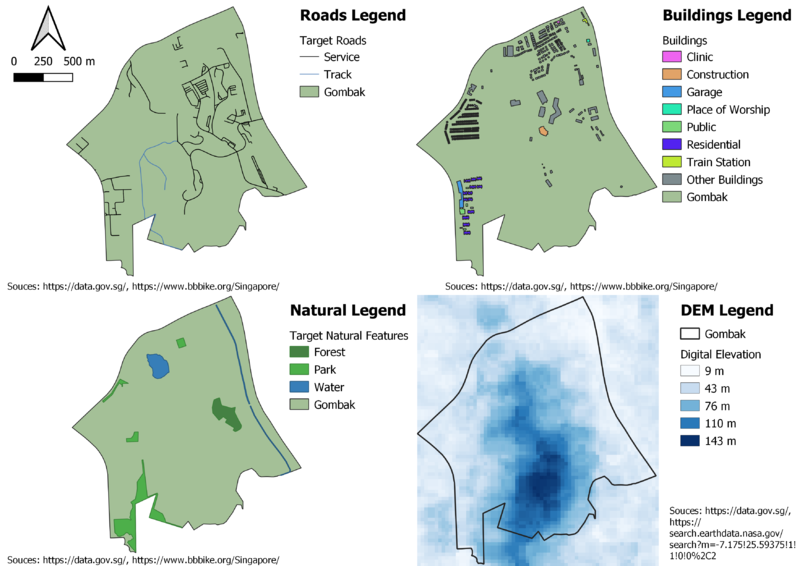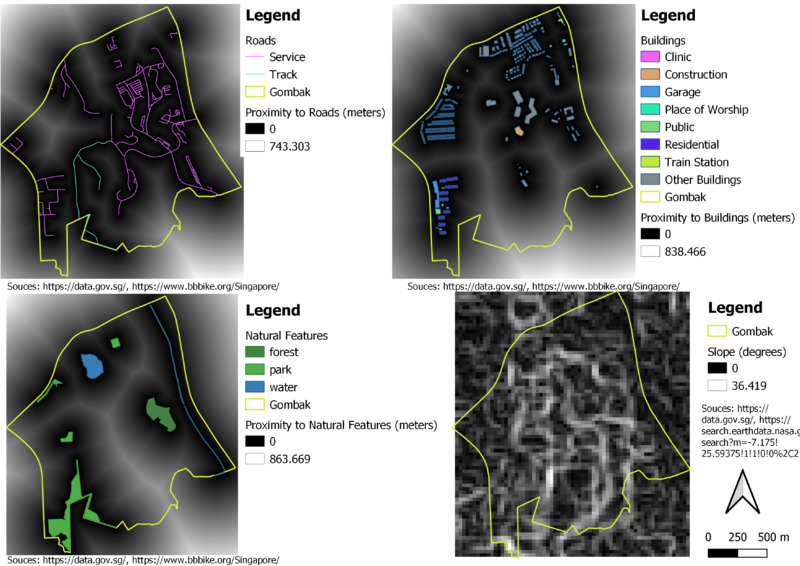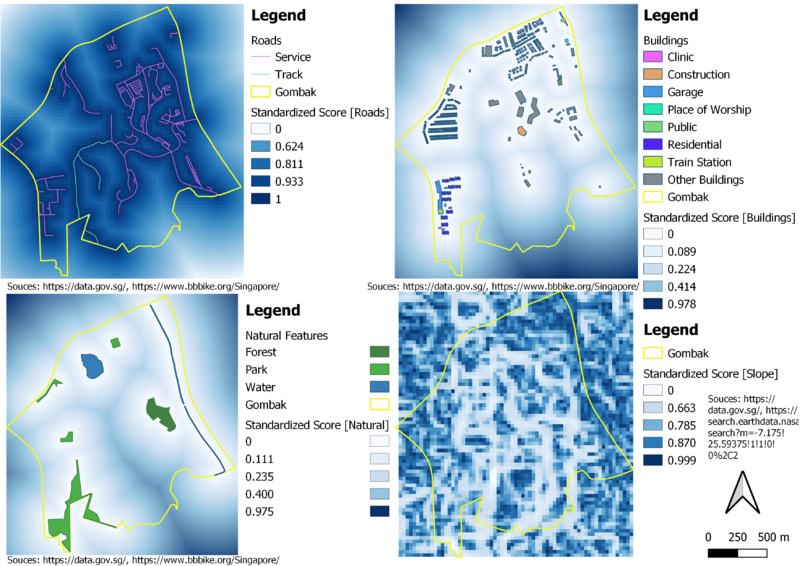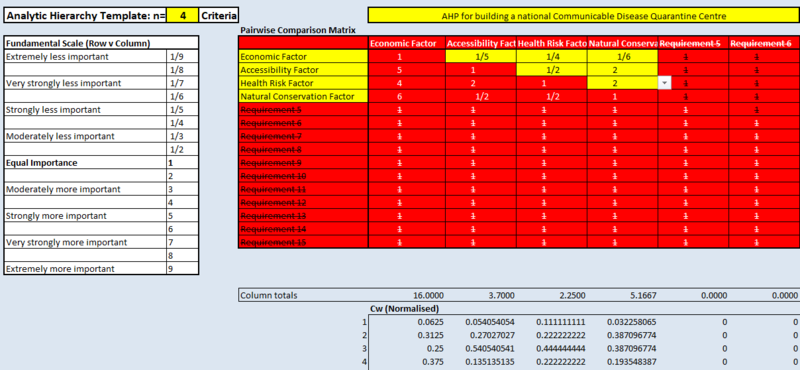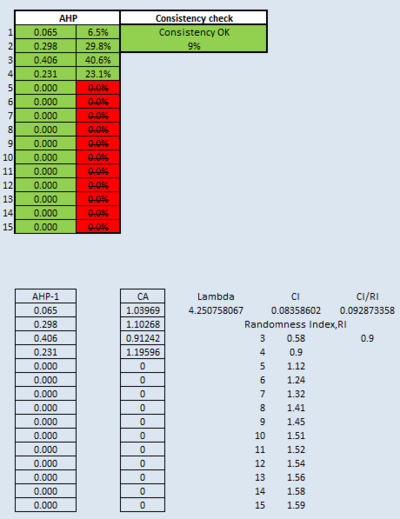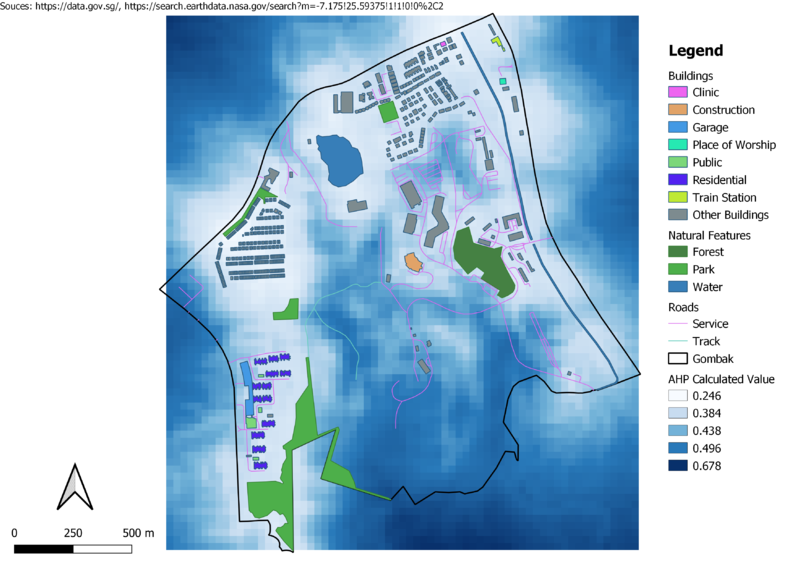SMT201 AY2019-20G1 EX2 Eddie Leow Kian Giap
Contents
- 1 Task
- 2 Part 1: Gombak and Roads, Buildings, Natural Features and Digital Elevation
- 3 Part 2: Gombak and Proximity to Roads, Buildings, Natural Features and Slope
- 4 Part 3: Criterion Scores of Each Factor Layers
- 5 Part 4: Analytical Hierarchical Process (AHP) Input Matrix & Result Report
- 6 Part 5: The Suitability Land Lot(s)
Task
To identify a location suitable for building a national Communicable Disease Quarantine Centre located at Gombak planning subzone with a contiguous area of at least 10,000m2.
Part 1: Gombak and Roads, Buildings, Natural Features and Digital Elevation
Gombak and Roads
This map layout will helps to identify the potential area to build the national Communicable Disease Quarantine Centre (CDQC) as the selected site should be close to existing service roads and tracks. Non service roads and tracks are not displayed in this map layout as the task is looking at target roads with study area (Gombak).
Gombak and Buildings
Based on the map layout, there are many types of buildings at Gombak such as clinics, constructions, garages, place of worship, public area, residential, train station and other buildings including private area. With the map layout, it aids in identifying the potential area to build the CQDC as the site should be away from population which means away from buildings.
Gombak and Natural Features
In this map layout, it helps to identify natural features such as forest, park and water at Gombak. This is to avoid the site being built near to these natural features and conserves the natural features.
Digital Elevation Model (DEM)
The tone of colour is used to identify the steepness of slope. The darker the blue, the steeper the slope. The lighter the blue, the less steep the slope. CQDC should avoid steep slope. With this map layout, it can helps to identify potential area with lesser degrees of slope. Therefore, lesser development cost to cut-and-fill.
Part 2: Gombak and Proximity to Roads, Buildings, Natural Features and Slope
Gombak and Proximity to Roads
The proximity to roads is represented by the gradient between black and white. The closer it is to black, the nearer it is to the roads. The closer it is to white, the further it is away from roads. The gradient provides a good and clear visualization of proximity to the roads. As the site for CDQC should be near existing service roads and tracks, this layout helps to determine where CDQC should be site at Gombak based on the proximity to roads.
Gombak and Proximity to Buildings
The proximity to buildings is represented by the gradient between black and white. The closer it is to black, the nearer it is to the buildings. The closer it is to white, the further it is away from buildings. The gradient provides a good and clear visualization of proximity to the buildings. This helps to determine where should CDQC be located at as it should be away from population.
Gombak and Proximity to Natural Features
The proximity to natural features such as forest, park and water is represented by the gradient between black and white. The closer it is to black, the nearer it is to natural features. The closer it is to white, the further it is away from the natural features. The gradient provides a good and clear visualization of proximity to the natural features. This map layout helps to determine where should CDQC be situated at based on the proximity of the natural features.
Gombak and Proximity to Slope
The degree of slope is represented by the gradient between black and white. The closer it is to black, the degree is closer to 0 degrees. This means that there is no slope or less steep slope. The closer it is to white, the degree is closer to 36.419 degrees. This means that there is a steeper slope. CDQC should be located at a less steep slope. With this layout, it helps to determine where is a suitable place to build CDQC.
Part 3: Criterion Scores of Each Factor Layers
Among all the criteria standardisation techniques, Min-Max technique will be apply to standardize the four raster layers from Part 2 to derive their criterion score.
Let X be the value.
The formula of Min-Max technique is [(X - Min) / (Max - Min)].
Criterion Score for Roads
Formula (in meters): 1 - [(X - 0) / (743.303 - 0)]
The higher the standardized value the nearer it is to the existing service roads and tracks.
The reason why there is a 1 subtracting Min-Max formula is to inverse the standardized value. The existing Min-Max technique will give a standardized value where the higher the standardized value, the further it is to the existing service roads and tracks. However, the decision factor for accessibility is to have the selected site close to existing service roads and tracks.
Criterion Score for Buildings
Formula (in meters): (X - 0) / (838.466 - 0)
The higher the standardized value, the further it is away from the buildings.
Criterion Score for Natural Features
Formula (in meters): (X - 0) / (863.669 - 0)
The higher the standardized value, the further it is away from forested land, park and water.
Criterion Score for Slope
Formula (in degrees): 1 - [(X - 0) / (36.419 - 0)]
The higher the standardized value, the lower the degree of the slope.
The reason why there is a 1 subtracting Min-Max formula is to inverse the standardized value. The existing Min-Max technique will give a standardized value where the higher the standardized value, the higher the degree of the slope. However, the decision factor for economic is the selected site should avoid steep slope.
Part 4: Analytical Hierarchical Process (AHP) Input Matrix & Result Report
Based on the AHP input matrix and result report above, health risk factor, accessibility factor, natural conservation factor and economic factor have AHP of 40.6%, 29.8%, 23.1% and 6.5%. Health risk factor is the most important factor when considering the place to build CDQC because CDQC is to isolate infected people away from healthy population. Accessibility factor is more important than the other two factors because time is key to save a life. With CDQC being build close to existing roads and tracks, it can reduce cost to build additional roads. Natural conservation factor is more important than economic factor because infectious diseases may spread through air or water and may cause mutation to trees in the park or forest. Lastly, economic factor should be considered when building CDQC. If the area has steep slope, there is more cost involved to reduce the steepness before building CDQC.
Part 5: The Suitability Land Lot(s)
To find out which area is suitable to build the CDQC, I have used the following formula.
Formula: ( "standardized_roads@1" * 0.298 ) + ( "standardized_buildings@1" * 0.406 ) + ( "standardized_natural@1" * 0.231 ) + ( "standardized_slope@1" * 0.065 )
AHP Calculated Value represents the suitability of the area based on the standardized value and the decision factors. The decision factors are accessibility factor, economic factor, natural conservation factor and health risk factor. A map layout is produced based on the AHP Calculated Value. Do refer below.
The darker the shade of blue, the more suitable it is to build CDQC at the area. The lighter the shade of blue, the less suitable it is to build CDQC at the area.
With that, a new map layout is produced with suitable areas being highlighted in yellow.
Suitable Area 1
This area is suitable to build CDQC because it is away from population, near to existing road (track), away from natural features and lower degrees of slope. The area is 122775.341 m² which is huge and sufficient to build CDQC. There is an existing service road falls within the suitable area. By tapping on the existing service road and build on it, it can save cost for the company.
Suitable Area 2
This area is suitable to build CDQC because it is away from population, near to existing road (track), away from natural features and lower degrees of slope. The area is 79079.186 m² which is huge and sufficient to build CDQC. There is an existing service road near the suitable area which can save cost from building additional road to link to main road.
Suitable Area 3
This area is suitable to build CDQC because it is away from population, near to existing road (track), away from natural features and lower degrees of slope. The area is 38016.334 m² which is huge and sufficient to build CDQC. There is an existing service road falls within the suitable area. By tapping on the existing service road and build on it, it can save cost for the company.
Conclusion
After comparing all three suitable areas, I would recommend to build CDQC on Suitable Area 1 because of the decision factors and AHP Calculated Value. Although the area may be near park and buildings compared to other suitable areas, Suitable Area 1 has the biggest area which CDQC needs at least 10,000 m². CDQC can be located in the middle of Suitable Area 1 so that it can be further away from the park and buildings while tapping on the existing service road.
